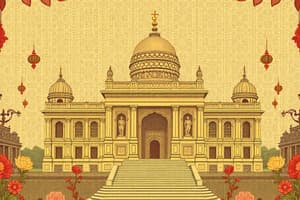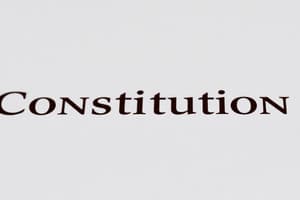Podcast
Questions and Answers
What is the key role of the Vice President of India?
What is the key role of the Vice President of India?
- Dissolves the Lok Sabha
- Head of the State
- Appoints the Prime Minister
- Ex-officio Chairperson of the Rajya Sabha (correct)
Which branch of the Indian government is responsible for appointing the Prime Minister?
Which branch of the Indian government is responsible for appointing the Prime Minister?
- President (correct)
- Chief Justice of India
- Governor of a State
- Vice President
How many articles constitute the Constitution of India?
How many articles constitute the Constitution of India?
- 300 articles
- 448 articles (correct)
- 365 articles
- 500 articles
In a federal state like India, what does each state have?
In a federal state like India, what does each state have?
What is the primary role of the Indian President?
What is the primary role of the Indian President?
What is the term length for members of the Rajya Sabha, the upper house of the Indian Parliament?
What is the term length for members of the Rajya Sabha, the upper house of the Indian Parliament?
Who has the power to dissolve the Lok Sabha in India under specific circumstances?
Who has the power to dissolve the Lok Sabha in India under specific circumstances?
Which judicial body in India has both original and appellate jurisdiction?
Which judicial body in India has both original and appellate jurisdiction?
What is the main function of the Union List and State List in the Indian Constitution?
What is the main function of the Union List and State List in the Indian Constitution?
Who appoints the judges of the Supreme Court and High Courts in India?
Who appoints the judges of the Supreme Court and High Courts in India?
Flashcards are hidden until you start studying
Study Notes
Indian Polity: A Comprehensive Overview
The Indian polity, shaped by the Constitution of India, is a fascinating blend of democratic, federal, and parliamentary elements. Let's delve into the key components of this elaborate and intricate system.
The Constitution of India
Adopted on January 26, 1950, the Constitution of India is the supreme law of the land, outlining the rights, duties, and powers of the various branches of the state. It consists of 448 articles, grouped into 22 parts and 12 schedules, and is considered one of the longest and most comprehensive constitutions in the world. The document establishes a federal system of government with a parliamentary democracy, and it has evolved over time through various amendments.
President and Vice President
The President of India is the head of the state, while the Vice President serves as the ex-officio Chairperson of the Rajya Sabha (the upper house of Parliament). Both are elected by an electoral college comprising elected members of the Parliament and state legislative assemblies. The President holds a largely ceremonial position but has some important constitutional powers, such as the right to appoint the Prime Minister, dissolve the Lok Sabha (lower house of Parliament), and grant pardons and reprieves.
Federalism
India is a federal state, meaning that it is organized into multiple units called states, each with its own government, legislature, and elected chief minister. The Constitution of India prescribes a dual polity, with both central and state governments sharing powers and responsibilities. The Center has exclusive legislative powers in areas such as defense, foreign affairs, and currency, while the states have exclusive powers in areas such as law and order, education, and public health. The Union List, State List, and Concurrent List outline the respective domains of the central and state governments.
Parliament
The Parliament of India is bicameral, consisting of the Rajya Sabha (upper house) and Lok Sabha (lower house). The Rajya Sabha is a permanent body, with its members serving for six years. The Lok Sabha, on the other hand, is elected for a five-year term, and its members are directly elected by the people. The President summons the first session of Parliament after every General Election, and this session is held at least once a year. The President also has the power to dissolve the Lok Sabha under certain conditions, such as if no party or coalition wins a majority of seats.
Judiciary
The Indian judiciary is independent and consists of various tiers, including the Supreme Court (the highest court of the land), High Courts (for each state and Union Territory), and lower courts (such as the District Courts). The Supreme Court has original jurisdiction in certain cases and appellate jurisdiction in all cases. The judges of the Supreme Court and High Courts are appointed by the President, upon the recommendation of a collegium of judges. The Judiciary plays a crucial role in upholding the rule of law and ensuring that the decisions of the government are in accordance with the Constitution.
In summary, the Indian polity is a complex system that combines elements of democracy, federalism, and parliamentary government. The Constitution of India provides a solid foundation for this system, while the President, Vice President, Parliament, and Judiciary serve as its cornerstones. As a citizen of India, understanding these components will help you engage with the political process and participate in the democratic life of our nation.
Studying That Suits You
Use AI to generate personalized quizzes and flashcards to suit your learning preferences.




